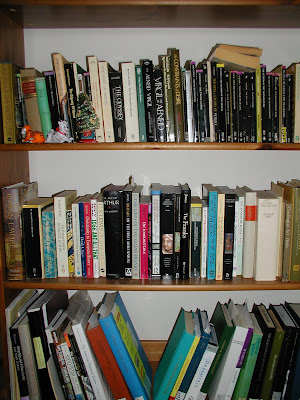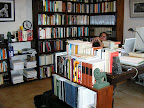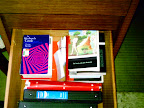 There have been a few times in the past when I have mentioned on this blog Nick Bostrom, philosopher [among other things], co-founder of the transhumanist movement , and director of The Future of Humanity Institute at Oxford University. Recently he has written a "Letter from Utopia," which is a kind of fictionalization of how a "possible" transhuman in the future might address we "mere humans" situated here in the present. I excerpt part of this letter here:
There have been a few times in the past when I have mentioned on this blog Nick Bostrom, philosopher [among other things], co-founder of the transhumanist movement , and director of The Future of Humanity Institute at Oxford University. Recently he has written a "Letter from Utopia," which is a kind of fictionalization of how a "possible" transhuman in the future might address we "mere humans" situated here in the present. I excerpt part of this letter here:The challenge I put before you is one of self-transformation. To grow up. This is not only about technology, but technology is necessary to participate in this way of life. If you want to live and play on my level, you need to acquire new capacities. To reach Utopia, and experience life here, you must discover the means to three fundamental transformations.
The First Transformation: Extend your life.
Your biological body, in it its current form, will not take you far. It wears out too soon. Eighty years is not enough even to get started in a serious way, much less to complete the journey. Maturity of the soul takes more than eighty vigorous years to develop. Why, even a tree-life takes more time to complete.
Death is not one but a multitude of assassins. Do you not see them? They are coming at you from every angle. Take aim at the causes of early death - infection, violence, malnourishment, heart attack, cancer. Turn a big gun on aging and fire. Claim control over the biochemical processes in your body in order to eliminate, by and by, illness and senescence. In time, you will discover ways to move your mind to more durable mediums. Then continue to improve the system, so that the risk of death and disease continues to decline. Any death prior to the heat death of the universe is premature if your life is good.
Oh, aging is a cruel cage. Gnaw and pull at the bars, and you will slowly loosen them up. One day you will break the grid that kept your forebears imprisoned. Gnaw and pull, redouble your efforts!
The Second Transformation: Amplify your cognition.
Your brain's special faculties: music, humor, spirituality, mathematics, eroticism, art, nurturing, narration and gossip! Aren't these the spirits with which to fill the cup of life? Blessed you are if you have a cask of any of these, or even as much as single vintage bottle.
Be not afraid to grow. The mind's cellars have no ceilings! But what other capacities are possible? Imagine a world with all music dried up - what poverty, what loss. Thank not the lyre but your ears for the music - and for the babbling brook, and the human voice.
What other harmonies are there in the air, that you lack the ears to hear? What vaults of value are you standing outside, lacking the key sensibility? Your brain needs to be enhanced beyond any genius of your kind, both in its special faculties and its general intelligence, so that you can learn, remember, and understand better.
Mind is a means: for without sagacity you will lose your way or get bogged down, and your journey will fail. Mind is also an end: for it is in the spacetime of awareness that Utopia will exist. May the measure of your mind be vast and expanding.
Oh, stupidity is a loathsome corral! Gnaw and pull at the poles, and you will slowly loosen them up. One day you will break the fence that held your forebears captive. Gnaw and pull, redouble your efforts!
The Third Transformation: Elevate your well-being.
What is the difference between indifference and interest, boredom and thrill, despair and euphoria? Pleasure. A few grains of this magic ingredient are worth more than a king's treasure, and we have it aplenty here in Utopia. It infuses everything we do and everything we experience. We sprinkle it in our tea.
The universe is cold. Fun is the fire that melts the blocks of hardship, and creates a bubbling celebration of life. It is the birth right of every creature, trampled upon since the beginning of time. There is a beauty and joy here that you cannot fathom. It feels so good that if the sensation were translated into tears of gratitude, rivers would overflow. I wish I could elaborate but language abandons me. I grope in vain for words to convey to you what all this amounts to…
I will not speak of the worst pain and misery that is to be got rid of; it is too horrible to dwell upon, and you are already aware of the urgency of palliation. My point is that in addition to the removal of the negative, there is also an upside imperative: to enable the full flourishing of enjoyments that are not currently viable. The roots of suffering are deep in your brain. Weeding them out and replacing them with nutritious crops of well-being will require fine instruments for the cultivation of mental soil.
For Nick Bostrom, utopia is akin to living forever ["any death prior to the heat death of the universe is premature if your life is good"], never growing old ["aging is a cruel cage"], never suffering the most painful emotions ["what a gruesome knot suffering is!"], only experiencing the positive, more euphoric emotions, and being all mind and no body ["mind is . . . an end"]. The fictional author of this letter, "Your Possible Future Self," is not something beyond or past the human [a pure machine, let's say, devoid of human-ness or human "parts"], but is rather, something further along the evolutionary human chain yet somehow stripped of everything we usually associate with "being human": mortality, limits to comprehension, passio, and the situation/habitation of time.
So here's my question to all of you: if you could live forever, would you want to? Would you still be human?

























